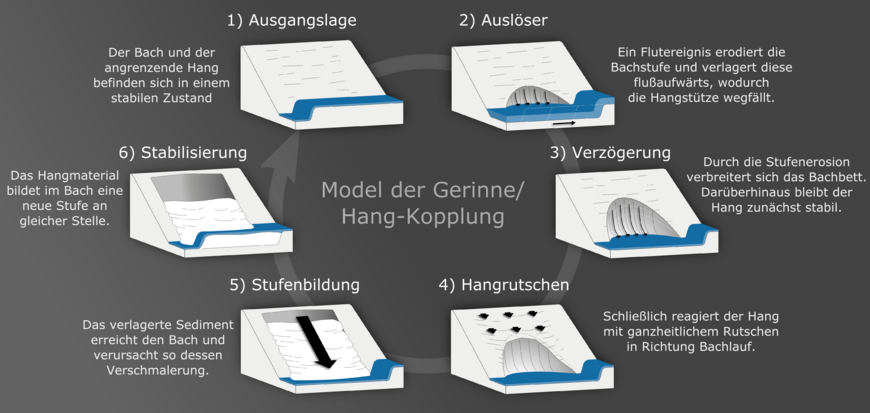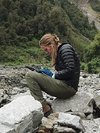The Geomorphology of Mountain Channels

In various observatories in the European Alps and in Asia we study the processes in and around mountain channels, and how these processes shape the channel. There are several focus areas:
- Rivers are the conveyer belts of the landscape – they move large amounts of sediment over long distances, from mountain regions to the ocean. Bedload transport is the motion of coarse sediment along the channel bed by bouncing, rolling and sliding. Bedload transport occurs when the forces of turbulent water flow mobilize a granular material. The process is physically complex and incompletely understood. Yet, it is of key importance in river dynamics and predictive equations are required in both engineering applications and in fundamental research. We study bedload transport mainly in the field and are working actively on improving available methods of measurement and developing new ones. On interesting new method exploits seismic and acoustic waves.
- Step-pool channel dynamics: steep channels build a typical step-pool morphology, where little waterfalls alternate with quiet pools. We try to understand why and how these steps develop and how they affect sediment transport through the stream.
- Rivers can cut spectacular canyons, and by doing so, they determine the pace of erosion of the entire landscape. We measure erosion rates and study the erosion processes to determine river response to extreme floods and changes in climate or tectonics.
- Bedrock channel morphology: Why does a bedrock channel pick a certain width and depth? And how does the river respond to extreme floods or changes in climate?
To answer these questions, we combine field observations, laboratory experiments and theoretical work.
Key Sites
- Taroko National Park, Taiwan: The Geomorphology section at GFZ has long been investigating river processes in the Taroko National Park and currently constructs a long-term observatory there.
- Da'an River, Taiwan: Since the ChiChi earthquake in 1999, the Da'an River has cut a spectacular gorge of about 1km length. Read more...
- Erlenbach, Switzerland: A well-instrumented catchment observatory run by the Swiss Federal Research Institute WSL, featuring the longest and most comprehensive high-quality bedload transport observations in the world.
Erosion Triggers Landslide – and the Hillslope Returns to a Stable Condition
Time-lapse Video Shows Fascinating Erosion Dynamics in a River Channel
27.01.2017: Rivers carry a lot of sediment which can potentially endanger infrastructure such as bridges or buildings. In order to improve risk assessment scientists investigate the processes of sediment transport. A team led by Antonius Golly from the GFZ German Research Centre for Geosciences presents direct observation of strong coupling between mountain channels and adjacent hillslopes. Their findings can help to estimate the time scales and the quantities of erosion and sediment load within rivers.
Golly and colleagues examined a channel step and an adjacent hillslope with a suspended landslide in the Erlenbach catchment in Switzerland. Monitoring was carried out using a camera system that takes a picture every 30 minutes over a number of weeks in 2014 and 2015 respectively. At the beginning, the 0.5 m high alluvial step in the alpine stream was stable, regardless of precipitation and water discharge. But then a heavy rainfall caused a larger flood resulting in strong erosion and a 4 m upstream migration of the step. Moreover, a bank failure ensued between the initial and the new step position as reported by the team in the GSA Journal Geology. A deep-seated hillslope motion was not apparent during this flood event. However, two days later, the hillslope entered a phase of integral motion. Subsequently the landslide refilled the stream bed until the original channel width was restored and the hillslope entered a stable condition again.
“Our monitoring data are direct observational evidence for the coupling of channels and hillslopes as proposed by previous studies based on indirect, large-scale terrain analyses and lab experiments”, says Antonius Golly of the GFZ’s section Geomorphology. “Our observations confirm that debuttressing by channel erosion can be a main cause of landslide activation.” This refutes the assumption that sediment delivery is mainly driven by the hydrology in the hillslope.
“Although the situation at the end of the cycle is quite similar to the initial state, sediment was delivered to the stream”, states Golly. Hence, this mechanism plays an important role for risk assessment. „Related hazards such as floods, mudflows and landslides can cause costs amounting to millions every year in Switzerland alone.” The scientists emphasize the importance of integrated channel-hillslope monitoring to improve the outcomes of risk analysis. The observed cycle is more common than one might think, explain the authors. The flood that triggered the hillslope failure in the Erlenbach had a recurrence interval of only 5 years. In other places such an event could happen even more frequently.
Original study: Golly, A., Turowski, J., Badoux, A., Hovius, N., 2017. Controls and feedbacks in the coupling of mountain channels and hillslopes. Geology, doi 10.1130/G38831.1




